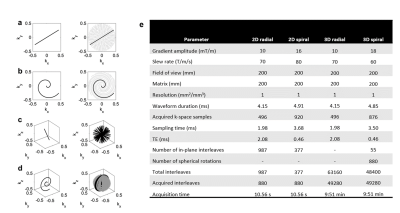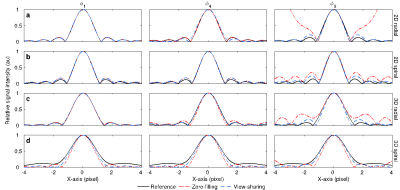3749
Effects of spatial encoding strategies on 2D and 3D magnetic resonance fingerprinting1University of Pisa, Pisa, Italy, 2Imago7 Foundation, Pisa, Italy, 3Technical University of Munich, Munich, Germany, 4University of Bath, Bath, United Kingdom, 5GE Healthcare, Munich, Germany, 6IRCCS Stella Maris, Pisa, Italy
Synopsis
Transient-state imaging techniques such as MR Fingerprinting allow for simultaneous quantification of tissue properties by using variable acquisition parameters in conjunction with undersampled non-Cartesian trajectories. Several implementations exist in literature, relying on two- or three-dimensional sampling readouts. Here, we studied the effect of the spatial encoding on quantification. In addition, an evaluation of the impact on parametric maps of anti-aliasing techniques (k-space weighted image constrast) was performed, both in vitro and in vivo.
Introduction
Transient-state MRI techniques such as MR Fingerprinting are an emerging tool in the field of quantitative MR imaging, due to their multiparametric quantification capability, their robustness to motion and system imperfections1. One distinct feature of transient-state techniques is the great flexibility in the choice of acquisition parameters for contrast encoding (such as variable Flip Angle and variable TE/TR schedules) and k-space trajectories for spatial encoding (both two- and three dimensional2–5). Here, we studied the most common 2D/3D readout strategies (i.e. 2D Radial/Spiral, 3D Radial/Spiral). In addition, we assessed the impact on quantification of an anti-aliasing processing step, specifically the k-space weighting technique6.Methods
TrajectoriesWe compared 2D/3D Spirals and 2D/3D Radial trajectories. All the readouts were based on rotations of an individual trajectory interleave from one frame to the next. For both 2D acquisitions, the interleave was rotated by a golden angle around the z-axis. For 3D Spiral acquisitions, trajectories were generated by encoding 2D spirals inside one (xy) plane and rotating this plane around the z-axis (see Cao et al.7). Finally, in 3D Radial k-space acquisitions, random permutations of spoke indexes were used to achieve full spatial coverage. Specific details for the waveforms are shown in Figure 1.
Acquisition and reconstruction
All the data were acquired on a GE HDxt 1.5T scanner using an 8-ch receiver coil, using FISP-based magnetic resonance fingerprinting2. Both phantom (Eurospin TO5 phantom8) and data from a healthy volunteer were acquired. The flip angle schedule is shown in Figure 2a, while fixed TE/TR = 0.46ms/12ms and 2.08ms/12ms were used respectively for spiral and radial acquisitions. The reconstruction pipeline is represented in Figure 2. Dictionary matching with EPG simulations9 was performed, obtaining quantitative T1, T2 and PD maps. To assess the accuracy of the measurements, phantom nominal values were used as well as 2D FISP-MRF acquisition with the original schedule from Jiang et al2.
Antialiasing
We evaluated an anti-aliasing pre-processing step before SVD compression, named here k-space weighted view-sharing (KW), based on k-space weighted image contrast6. This method allows, given an appropriate weighting function, to share data among adjacent frames to increase the sampling of individual frames (Figure 1 and 2), thus reducing aliasing, without compromising the contrast. We set the weights as a function of the sampling density (i.e. proportional to the trajectory DCF), enabling us to compare readouts with distinct density patterns (i.e. spirals and radials). We also validated the entire pipeline in silico, simulating the acquisition of time-domain data of a single representative white matter voxel (T1 = 600 ms, T2 = 70 ms) using all trajectories. The data were then reconstructed to obtain a point spread function (PSF) in image space for each temporal coefficient, with and without KW view-sharing, and compared to a fully-sampled case.
Results
In silico validationFigure 3 shows the results of the PSF analysis, showing that all undersampled readouts approximate the fully-sampled PSF for the first SVD coefficient, whereas view-sharing significantly improves the PSF with respect to zero-filling in lower energy coefficients, where the sidelobes of the PSF were reduced by an order of magnitude.
In vitro validation
T1/T2 quantification results are summarized in Figure 4. All the acquisitions, regardless of the readout trajectories, give comparable results to the reference. In addition, while KW view-sharing does not negatively affect quantification accuracy it reduces of standard deviations with respect to zero-fill reconstruction.
In vivo validation
Figure 5 shows the results for in vivo acquisitions. All trajectories benefit from this anti-aliasing pre-processing step. However, for extreme undersampling factors such as in the 3D Radial case, aliasing artifacts cannot be completely recovered even with the use of view-sharing, therefore leading to blurred T2 maps. Overall, the best results were obtained with 3D spiral projections in combination with KW view-sharing.
Discussion and conclusion
In this work, we studied different 2D and 3D non-Cartesian trajectories for transient-state acquisitions at the basis of MRF, and evaluated the impact of non-iterative anti-aliasing technique on quantification. Overall, quantification was agnostic with respect to the specific sampling strategy and anti-aliasing pre-processing step used. Phantom results were in good agreement both with gold-standard based nominal values and FISP-MRF based measurements. This represents an important result, since it enables the comparison of images obtained from these different spatial encoding strategies. While all the trajectories achieved a similar accuracy, spiral trajectories showed substantially reduced undersampling artifacts, resulting in a diminished standard deviation of the measurements. Conversely, quantification errors due aliasing errors for highly undersampled trajectories (such as 3D Radial) were still visible. However, all trajectories (including 3D Radial) benefitted from the KW view-sharing processing, resulting in a substantial reduction of aliasing artifacts. In conclusion, transient-state MRI acquisitions provided accurate estimations irrespectively of the specific k-space trajectory used, while the use of KW view-sharing could mitigate undersampling artifacts in all the cases here tested.Acknowledgements
Support from the Italian Ministry of Health and the Tuscany Region under the project “Ricerca Finalizzata”, Grant n. GR-2016-02361693.References
1. Ma, D. et al. Magnetic resonance fingerprinting. Nature 495, 187–92 (2013).
2. Jiang, Y., Ma, D., Seiberlich, N., Gulani, V. & Griswold, M. A. MR fingerprinting using fast imaging with steady state precession (FISP) with spiral readout. Magn. Reson. Med. 74, 1621–1631 (2015).
3. Cloos, M. A. et al. Multiparametric imaging with heterogeneous radiofrequency fields. Nat. Commun. 7, 12445 (2016).
4. Liao, C. et al. 3D MR fingerprinting with accelerated stack-of-spirals and hybrid sliding-window and GRAPPA reconstruction. Neuroimage 162, 13–22 (2017).
5. Cao, X. et al. Fast 3D brain MR fingerprinting based on multi-axis spiral projection trajectory. Magn. Reson. Med. 82, 289–301 (2019).
6. Song, H. K. & Dougherty, L. k-Space weighted image contrast (KWIC) for contrast manipulation in projection reconstruction MRI. Magn. Reson. Med. 44, 825–832 (2000).
7. Xiaozhi Cao, Congyu Liao, Qing Li, Huihui Ye, Hongjian He, J. Z. Fast 3D MR fingerprinting with spiral projection acquisition for whole brain quantification imaging. in Proceedings of the 26th Annual Meeting of ISMRM 1017 (2018).
8. Lerski, R. A. & de Certaines, J. D. Performance assessment and quality control in MRI by Eurospin test objects and protocols. Magn. Reson. Imaging 11, 817–833 (1993).
9. Weigel, M. Extended phase graphs: Dephasing, RF pulses, and echoes - Pure and simple. J. Magn.
Figures




